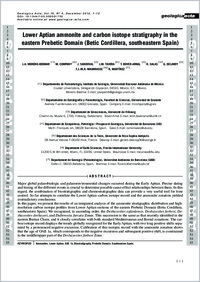Lower Aptian ammonite and carbon isotope stratigraphy in the eastern Prebetic Domain (Betic Cordillera, southeastern Spain)
- Moreno-Bedmar, Josep A. Departamento de Paleontología, Instituto de Geología, Universidad Nacional Autónoma de México, México.
- Company, M. Departamento de Estratigrafía y Paleontología, Facultad de Ciencias, Universidad de Granada, Spain
- Sandoval, J. Departamento de Estratigrafía y Paleontología, Facultad de Ciencias, Universidad de Granada, Spain
- Tavera, J. M. Departamento de Estratigrafía y Paleontología, Facultad de Ciencias, Universidad de Granada, Spain
- Bover-Arnal, Telm Département de Géosciences, Université de Fribourg, Switzerland
- Salas, R. Departament de Geoquímica, Petrologia i Prospecció Geològica, Universitat de Barcelona, Spain
- Delanoy, G. Département des Sciences de la Terre, Université de Nice-Sophia Antipolis, France
- Maurrasse, F. J.-M. R. Department of Earth Sciences, Florida International University, United States
- Martínez, R. Departament de Geologia, Universitat Autònoma de Barcelona, Bellaterra, Spain
-
2012
Published in:
- Geologica Acta. - 2012, vol. 10, no. 4, p. 333-354
English
Major global palaeobiologic and palaeoenvironmental changes occurred during the Early Aptian. Precise dating and timing of the different events is crucial to determine possible cause-effect relationships between them. In this regard, the combination of biostratigraphic and chemostratigraphic data can provide a very useful tool for time control. So far attempts to correlate the Lower Aptian carbon isotope record and the ammonite zonation yielded contradictory conclusions. In this paper, we present the results of an integrated analysis of the ammonite stratigraphic distribution and highresolution carbon isotope profiles from Lower Aptian sections of the eastern Prebetic Domain (Betic Cordillera, southeastern Spain). We recognized, in ascending order, the Deshayesites oglanlensis, Deshayesites forbesi, Deshayesites deshayesi, and Dufrenoyia furcata Zones. This succession is the same as that recently identified in the eastern Iberian Chain, and it closely correlates with both standard Mediterranean and Boreal zonations. The carbon isotope record displays the trends globally recognized for the Early Aptian, with two long positive shifts separated by a pronounced negative excursion. Calibration of this isotopic record with the ammonite zonation shows that the age of OAE 1a, which corresponds to the negative excursion and subsequent positive shift, is constrained to the middle/upper part of the Deshayesites forbesi Zone.
- Faculty
- Faculté des sciences et de médecine
- Department
- Département de Géosciences
- Language
-
- English
- Classification
- Palaeontology
- License
- License undefined
- Identifiers
-
- RERO DOC 31331
- DOI 10.1344/105.000001752
- Persistent URL
- https://folia.unifr.ch/unifr/documents/302789
Statistics
Document views: 101
File downloads:
- bov_laa.pdf: 114
